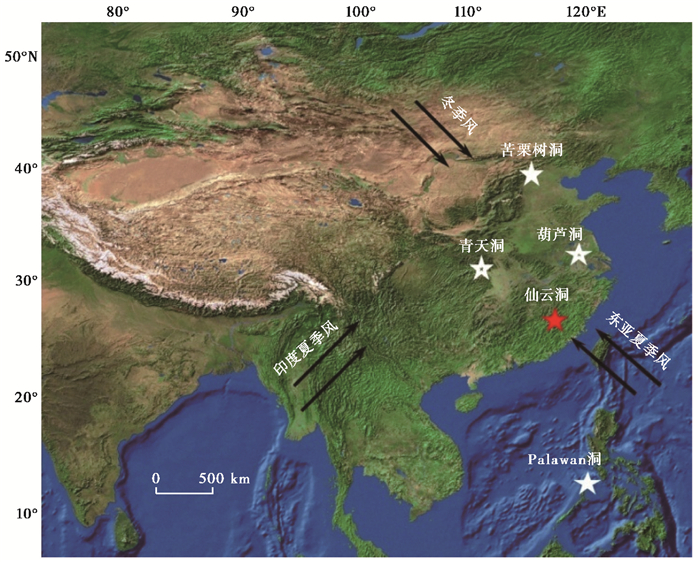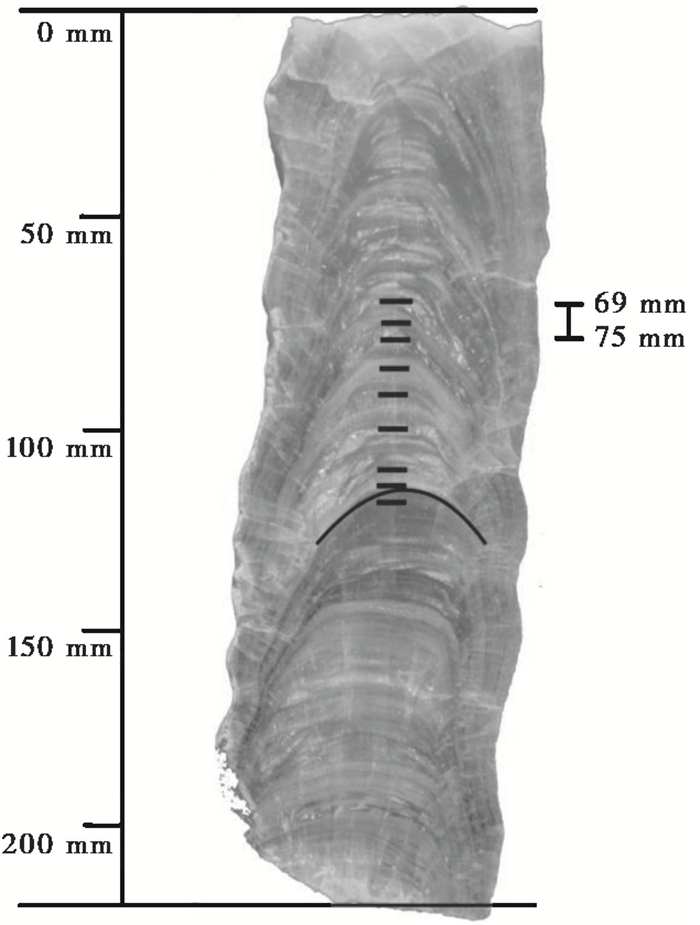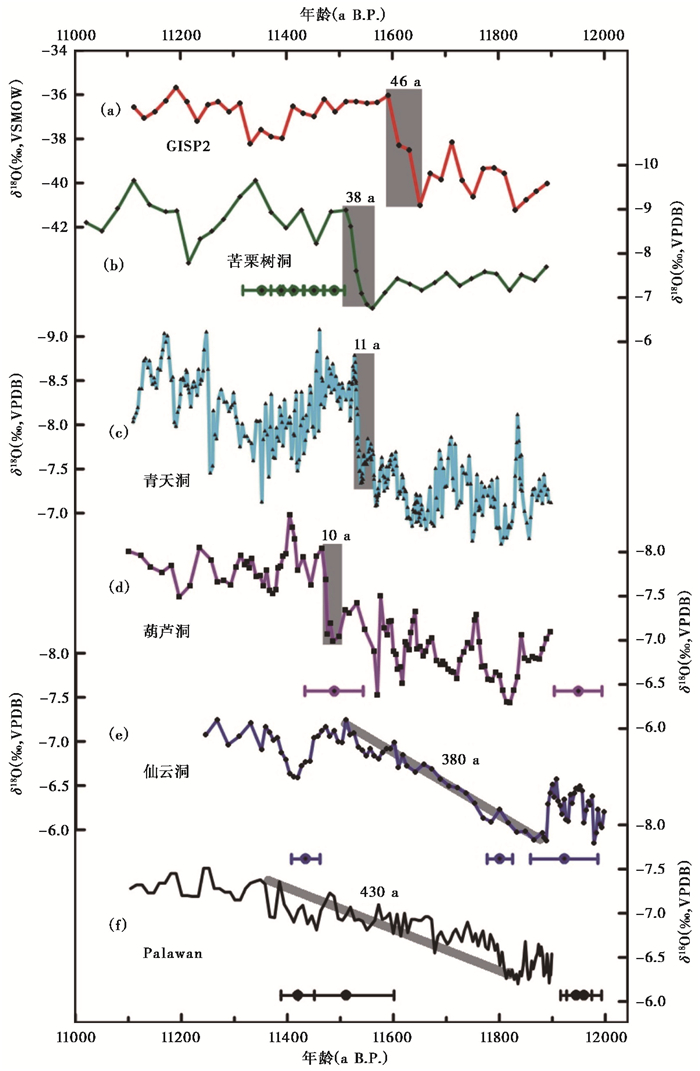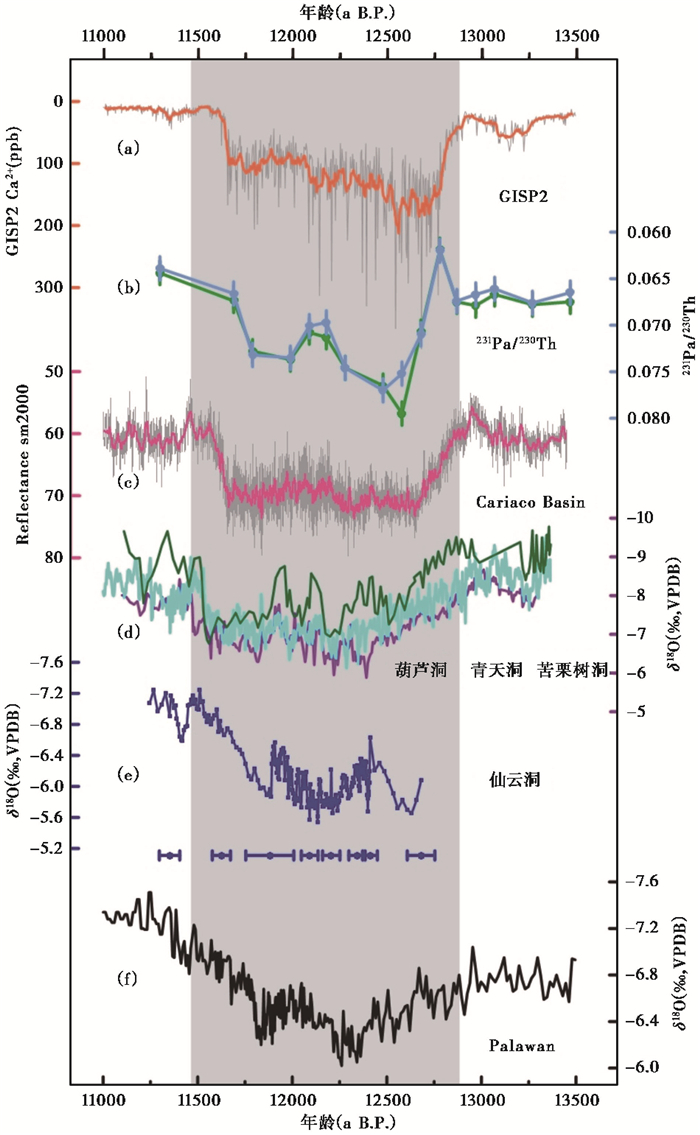2 福建师范大学地理研究所, 福建 福州 350007)
新仙女木(Younger Dryas,简称YD)事件的命名来源于19世纪晚期欧洲瑞典和丹麦等地第四纪地层孢粉记录中发现的北极苔原植物仙女木[1]。YD事件发生在约12.9~11.6 ka B.P. (B.P.为相对于公元1950年,下同),是末次冰消期升温过程中的一次急剧降温性突变事件。格陵兰冰芯记录显示当地的温度降低到接近冰期的程度,比现在低约15 ℃[2]。由于发生时间距离现在较近,在全球范围内获得的记录较为丰富,YD事件是迄今为止全球范围内研究最为详尽的气候突变事件,也是过去30年来古气候研究的热点。
YD事件被广泛发现于北大西洋周围陆相和海相记录中[3~5],后来在北太平洋、亚洲、北美、热带地区甚至南半球地区均有发现[6~7]。YD事件被认为是一次全球性的气候变化事件,对全球的平均温度以及水文循环有着重大影响。YD事件时,北半球中高纬度地区气候均呈现大幅度的降温特征[8]。YD事件期间亚洲夏季风减弱[9~13],而南半球的印度尼西亚则更加潮湿[14],南美夏季风则增强[10, 15~16]。
尽管关于YD事件的研究已经开展的比较全面深入。然而,由于受早期记录的年龄模式、样品的分辨率、气候代用指标的敏感性以及区域环境等因素的影响,关于该事件的讨论仍然存在一定的争议。尤其是,随着近年来高分辨率地质记录的不断涌现,YD事件时空差异性日益显出。例如,高分辨率的我国北方苦栗树洞[17]、南京葫芦洞[9]和神农架青天洞[12]等石笋δ18O记录,详细记录了YD事件结束时东亚夏季风的变化过程,其YD结束时间分别为38 a、10 a和11 a。而热带低纬度地区的菲律宾Palawan洞穴高分辨率的石笋记录则揭示出YD事件结束时间的缓慢性(约430 a)[18]。为更好地了解YD事件结束阶段的差异响应,有必要从中低纬度地区,尤其是研究空白区获得更多具有高分辨率和精确定年的气候记录的证据。
本研究根据我国东南部福建仙云洞XYⅣ-14石笋8个高精度U/Th定年数据及233个稳定氧同位素数据,建立了12.68~11.25 ka B.P.期间平均分辨率达7 a的东亚季风演化的δ18O变化序列,揭示出我国东南部典型东亚季风区YD事件的变化特征。通过与已有高分辨率石笋记录和高低纬古气候记录对比,探讨其变化特征及可能的影响机制。
1 材料与方法仙云洞(25°33′N,116°59′E)位于福建省西部连城县赖源乡(图 1),该洞长约1200 m,上覆30~50 m二叠纪石灰岩,洞口海拔970 m。洞穴呈现阶梯状向里倾斜延伸,洞厅宽阔,封闭性较好,洞内相对湿度接近100 % (2017年5~8月测)。洞内滴水点众多,次生碳酸盐沉积物发育良好。仙云洞位于亚热带海洋性季风气候区,受典型的东亚季风影响,全年气候温和,无霜期长,雨量充沛,年平均气温为19~21 ℃,降雨量为1600~1800 mm,主要集中于4~10月。洞内实测温度为17.5 ℃,与洞外年均温较为接近。

|
图 1 仙云洞地理位置图 Fig. 1 Location of the Xianyun cave |
研究石笋(编号:XYⅣ-14)采集于仙云洞底层(第3层)的一个平台之上,样品长约210 mm,直径约65 mm(图 2)。采集时样品已经断裂,未找到断面以上的顶部。样品顶底直径差别不大,整体上下比较匀称,生长发育较稳定。沿中心生长轴切开并抛光,抛光面透明纯净,在样品上面部分存在少量溶孔,样品某些部分存在清晰可见的纹层,样品靠下部分颜色较深。在样品的110 mm左右存在一条暗色条带,为沉积间断,本文集中研究60~109 mm层段。

|
图 2 仙云洞XYⅣ-14石笋抛光面图 黑色短线为测年点,69~75 mm表示YD事件结束过程层段,黑色曲线表示沉积间断 Fig. 2 Photos for stalagmite XYⅣ-14 from Xianyun cave, Southeast China. The black rectangles indicate the positions of dated sub-samples. 69~75 mm represents the layer of the end of YD event. Black curve indicate sediment discontinuity |
用直径0.9 mm的钻头在石笋抛光面沿着生长轴上共钻取了9个样品用于230Th定年(图 2),分析仪器为MC-ICP-MS Neptune,方法参照Shen等[19],由台湾大学高精度质谱与环境变迁实验室(HISPEC)测试完成。将石笋沿着生长轴切割成具有1/ 4断面的长柱状体,60~65 mm之间,用直径0.5 mm钻头,以1 mm间隔钻取样品5个。为提高研究时段样品分辨率,在石笋65~109 mm之间采用刻刀削刮法每1 mm刮取10个样品。为防止刮取的粉末前后混合干扰,从每毫米刮取的10个样品中挑选偶数编码的5个样品,共计228个。因此,在60~109 mm之间总计233个样品进行稳定同位素测试。采用连续流Gasbench装置与Finnigan MAT-253型质谱仪联机测试,每9个样品加测一个标准样品(NBS-19),结果以δ18O(‰,VPDB)表示,计算公式为δ18O= [(18O/16O样品) /(18O/16O标准)-1]×1000,分析误差(± 2σ)优于0.06‰,由福建师范大学同位素实验室测试。
2 结果 2.1 年龄模式石笋XYⅣ-14的U、Th同位素组分和230Th年龄测试结果见表 1。定年结果显示XYⅣ-14样品238U含量较高(平均约780×10-9 g/g),232Th的含量低(平均约1180×10-12 g/g),230Th定年的精度整体较高,测年误差多在± 39~± 74 a之间,仅有一个误差较大(± 127 a),所有年龄符合石笋生长层序。从定年结果来看,110 mm处确为沉积间断,石笋停止生长了约600多年,因此114 mm处的定年结果不予采用。由于在65 m处定年为11.35 ka B.P.,由外推法获得60 mm处年龄为11.25 ka B.P.,因此根据对8个年代标尺采用线性内插和外推法,建立了12.68~11.25 ka B.P.时段的年代标尺。从石笋年龄-深度曲线图(图 3)可以看出,在距顶65~75 mm层段其平均生长速率是0.019 mm/a;距顶75~107 mm层段其平均生长速率是0.060 mm/a;距顶107~109 mm层段其平均生长速率为0.007 mm/a。根据氧同位素分析的采样间隔及230Th精确定年数据,12.41~11.35 ka B.P.平均分辨率达5 a,而12.68~12.41 ka B.P.平均分辨率为23 a。
| 表 1 仙云洞石笋XYⅣ-14的230Th测年结果* Table 1 230Th dating results for stalagmite XYⅣ-14 from Xianyun cave |

|
图 3 仙云洞石笋XYⅣ-14年龄-深度曲线(a)和氧同位素时间序列(b) 深灰色部分表示YD事件结束阶段,误差棒表示石笋230Th测年点及测年误差(±2σ);图中的①和②表示百年尺度季风增强事件 Fig. 3 Stalagmite XYⅣ-14 230Th dating-depth model and δ18O records from Xianyun cave. ① and ② show the centennial scale strong monsoon events. Dark gray indicate the end of the YD event. Error bars represent the dating points and dating errors |
根据石笋XYⅣ-14氧同位素曲线变化趋势(图 3),可以将其分为3个阶段:1)在12.68~11.89 ka B.P.,其δ18O值整体正偏,其值在-6.6‰~-5.5‰之间变化,平均值为-6.0‰,对应于YD事件;2)在11.89~11.51 ka B.P.,在此时段δ18O值由-5.9‰偏负至-7.2‰。根据YD转换阶段δ18O值的最偏正值和最偏负值所对应的内插年龄来判断此转换时间为380 a。误差根据此阶段两个230Th年龄(11881±127 a B.P.和11625±48 a B.P.)的测年误差(127 a和48 a),采用平方平均数算得误差为95 a。仙云洞石笋δ18O约380±95 a内缓慢负偏1.3‰,对应于YD事件的结束阶段;3)在11.51~11.25 ka B.P.,其δ18O值整体负偏,其值在-7.7‰~-6.6‰之间变化,平均值为-7.1‰,对应于早全新世。另外,该δ18O记录显示在12.68~11.89 ka B.P.,即YD事件期间,还存在2个百年尺度的季风增强事件①和②(图 3)。这种百年尺度的气候事件在其他东亚季风区石笋记录中也有发现[12, 17],说明YD事件内部的气候变化的不稳定性。
3 讨论 3.1 仙云洞石笋δ18O指示意义及其记录的YD结束的缓变特征目前,对东亚季风区石笋δ18O所指示的气候意义存在争议,但东亚季风区内各洞穴石笋δ18O记录在轨道-千年尺度具有大范围的区域一致性,说明该区石笋δ18O记录最有可能是反映了夏季风强度[20~22],具有全球性意义。最近,Cheng等[23]指出东亚夏季风(EASM)地区石笋δ18O值变化一般指示平均气候状态下的夏季风强度变化,即δ18O值偏正指示夏季风减弱,反之亦然。此解释也得到模型研究结果的支持[24]。基于年层时间标尺的葫芦洞和青天洞石笋δ18O记录在百年甚至更短时间尺度上的一致性变化,以及δ18O和纹层厚度变化的一致性,进一步支持东亚石笋δ18O能够反映东亚夏季风强度变化的解释[25]。已有的东亚季风区石笋记录都清晰地刻画了YD事件详细的变化特征[9, 17, 26]。如图 4所示,在定年误差范围内,洞穴石笋记录在YD事件时δ18O均整体偏重,而在YD结束时均表现出明显的偏负特征,具有整体一致性,说明同位于东亚季风区的仙云洞石笋记录在千年尺度气候事件上指示了季风强度的变化,即季风越强,石笋氧同位素越偏负,反之则偏正。

|
图 4 YD结束阶段不同记录的对比 (a)GISP2 δ18O[29];(b)苦栗树洞石笋δ18O记录[17];(c)青天洞石笋δ18O记录[26];(d)葫芦洞石笋δ18O记录[9];(e)仙云洞δ18O记录;(f)Palawan石笋δ18O记录[18]不同颜色的误差棒为各自石笋记录的测年点及误差(±2σ);深灰色粗线表示各记录YD结束时期的转换过程 Fig. 4 Comparison of δ18O records of different records in YD. (a)GISP2 δ18O record[29]; (b)Kulishu cave δ18O record[17]; (c)Qingtian cave δ18O record[26]; (d)Hulu cave δ18O record[9]; (e)Xianyun cave δ18O record(this study); (f)Palawan cave δ18O record[18]. 230Th ages and errors are color-coded by caves. The dark gray thick lines indicate the changes in YD |
YD结束阶段在众多记录中表现出极为快速的变化过程,但不同指标记录的转换细节存在显著差异。冰芯记录的冰雪累积速率在1~3 a内增加1倍[27],完成YD/Holocene转换。GIRP冰芯过剩氘和粉尘浓度在20 a内完成转换[28],δ18O记录指示的气温转换历时约46 a[29](图 4a)。这种快速的转变模式在基于GICC05年层时标的格陵兰NGRIP冰芯过剩氘记录中同样存在[30]。
尽管在定年误差范围内,我国已有的洞穴石笋氧同位素记录的YD事件的结束具有同步性,但在YD结束阶段的持续时间上却差异明显。基于年层时标的湖北青天洞石笋显示,YD快速的结束过程在11.54 ka B.P.时δ18O值由最偏负到最偏正历时约11 a[26](图 4c)。位于东亚季风区的南京葫芦洞石笋记录显示在YD结束附近的δ18O值偏正过程只用了少于10 a[9](图 4d)。这种快速的转变模式同样存在于我国北方石笋记录中:基于纹层计数的苦栗树洞石笋记录的11.56±0.04 ka B.P.时的转换时间少于38 a,最快估计为20 a[17](图 4b)。由图 4可以看出,相对于已有的中国石笋纪录及冰芯记录的YD结束时的突变型,仙云洞石笋显示δ18O值从约11.89 ka B.P.开始逐步缓慢负偏,在约380±95 a内缓慢负偏1.3‰ (图 4e)。仙云洞石笋记录的YD结束时间(380±95 a)比苦栗树洞、葫芦洞和青天洞记录(38 a、10 a和11 a)要长的多。仙云洞石笋记录在YD事件结束阶段共有2个230Th年龄,其中一个年龄标定在YD结束的开始位置,即11.89 ka B.P.。格陵兰GISP2冰芯记录[29]、苦栗树洞记录[17]、葫芦洞记录[9]和青天洞记录[26]的YD事件结束时间分别为约11.6 ka B.P.、11.56±0.04 ka B.P.、11.48±0.1 ka B.P.和11.54±0.07 ka B.P.之间。因此,仙云洞YD结束过程时间比其他洞穴记录和格陵兰冰芯记录要早约300 a。上述差异时间也远在定年误差范围之外。仙云洞石笋记录的YD结束时的缓变特征却与菲律宾Palawan洞石笋记录[18]比较相似(图 4f)。菲律宾Palawan洞石笋δ18O记录显示,11.79~11.36 ka B.P.时石笋δ18O值在430 a内由-6.6‰偏负至-7.4‰,表现出缓慢负偏的特征。低纬菲律宾Palawan地区和我国东南沿海福建地区,在YD结束时缓变性呈现出与高纬格陵兰冰芯记录和我国北方及长江中下游石笋记录突变特征明显不同的响应模式。
3.2 YD事件的驱动机制探讨YD气候突变事件由于其突变性,在全球范围内影响较广[3~7, 31~32],大洋与大陆记录之间的差异性等因素,使得关于该事件的驱动机制讨论的争议一直存在。Berger[33]在总结前人研究的基础上提出了YD事件可能的驱动机制:包括反照率、大气二氧化碳含量等在内的气候系统的正反馈;太阳辐射、火山喷发和宇宙尘埃等气候系统外部驱动;大陆冰盖的崩塌。此后,基于理论研究和数值模型模拟的不断深入,新的触发机制不断提出。
北大西洋气候在千年尺度气候突变事件上对东亚季风气候具有调控作用[9, 34~39]。末次冰消期时全球冰量开始消融,大量冰盖由于内部不稳定或大气冷循环作用,浮冰注入北大西洋,形成规模巨大的冰漂碎屑带。冰漂碎屑事件发生时[40],北大西洋深海沉积物中231Pa/230Th比值记录[41](图 5b)表明AMOC减弱。AMOC的减弱导致北大西洋温度降低,海冰范围增加,使得北大西洋及格陵兰地区的温度降低,同时将ITCZ向南推移[42]。仙云洞、葫芦洞[9]、青天洞[26]和苦栗树洞[17]氧同位素记录在YD时期的偏正过程,在定年误差范围内与Cariaco Basin反照率记录[43](图 5c~5e)的ITCZ南移时间一致,进一步支持AMOC通过改变ITCZ位置来调节亚洲季风[25]。早前研究表明格陵兰冰芯粉尘记录一般反映其粉尘源区(亚洲沙漠)的气候变化[44],格陵兰冰芯中Ca2+浓度记录(图 5a)说明在YD时期,陆源大气环流传输发生了与仙云洞及其他记录一致的变化趋势;同样,在此时段,德国湖泊沉积纹泥年层变厚,这说明此时有更强的风将更多的陆表物质带入到湖泊中[45~46],指示了中纬西风带加强,东亚夏季风减弱。

|
图 5 仙云洞石笋δ18O与高低纬古气候记录对比 (a) GISP2 δ18O[29];(b)北大西洋沉积物231Pa/230Th记录[41];(c)Cariaco盆地反照率记录[43];(d)葫芦洞石笋δ18O记录(紫色)、苦栗树洞石笋δ18O记录(绿色)和青天洞石笋δ18O记录(天蓝色)[9, 17, 26];(e)仙云洞石笋δ18O记录;(f)Palawan洞石笋δ18O记录[18]不同颜色的误差棒为各自石笋记录的测年点及误差(±2σ) Fig. 5 Comparison of δ18O records between Xianyun cave and high-low latitude climate records. (a)GISP2 δ18O record[26]; (b) 231Pa/230Th, a proxy for Atlantic Meridional Overturning Circulation(AMOC)[41]; (c)Sediment reflectance record from the Cariaco Basin[43]; (d)Spliced stalagmites δ18O records from Hulu cave, Qingtian cave and Kulishu cave[9, 17, 23]; (e)Xianyun cave δ18O record (this study); (f)Palawan cave δ18O record[18]. 230Th ages and errors are color-coded by caves |
然而,仙云洞石笋记录的YD结束过程时间(380±95 a)比格陵兰冰芯记录(46 a),苦栗树洞、葫芦洞和青天洞记录(38 a、10 a和11 a)要长的多。上述差异说明另有北高纬驱动之外的因子影响我国东南仙云洞的石笋氧同位素变化。Partin等[18]基于菲律宾Palawan洞穴和东亚季风区洞穴石笋记录与格陵兰冰芯记录的对比,发现越靠近热带西太平洋地区YD事件的结束过程越长。他们通过进一步的模型模拟结果认为,受热带西太平洋水文气候影响的低纬度地区对气候突变响应所需要的时间比受海冰影响的高纬地区更长[18]。仙云洞石笋记录和菲律宾Palawan洞穴石笋记录在YD结束时的相似性(图 4f和图 5f),一方面说明仙云洞石笋记录能够敏感的反映出热带低纬水文循环的变化过程,另一方面也说明热带低纬海气耦合过程有可能是引起两地YD事件结束缓变特征的主要因素。研究表明,淡水注入北大西洋,AMOC停滞或减弱是触发YD事件的主要原因[41]。热带西太平洋钻孔记录[47]则表明,低纬西太平洋地区在YD时期为缓慢增温的过程。热带西太平洋作为东亚季风源区及全球重要的水汽来源,其水热变化对全球气候变化有着重要的影响[48]。在YD时期,随着热带西太平洋温度的不断上升,低纬的热量不断积聚,距离水汽源区较近的菲律宾和我国东南地区受低纬海气耦合过程的影响,因而YD结束较早且呈现缓变的特征。
4 结论(1) 仙云洞石笋9个高精度230Th年龄和233个氧同位素分析,建立了12.68~11.25 ka B.P.时段平均分辨率达7 a的东亚夏季风强度的演变序列。在11.89~11.51 ka B.P.时段,δ18O记录在380±95 a内总体偏负约1.3‰,指示YD事件的缓慢结束过程。
(2) 与基于年层时标的我国北方苦栗树洞、南京葫芦洞和神农架青天洞石笋记录对比发现,我国东南仙云洞记录的YD事件结束过程的时间(380±95 a)明显比苦栗树洞、葫芦洞和青天洞记录(38 a、10 a和11 a)要长的多。在定年误差范围之内,仙云洞YD结束过程时间比其他洞穴记录和格陵兰冰芯记录要早约300 a。仙云洞石笋所记录的YD事件缓慢结束的特征与低纬菲律宾Palawan洞穴石笋记录十分相似。
(3) 仙云洞石笋δ18O记录及其与其他高低纬气候记录对比显示,除北大西洋气候在千年尺度气候突变事件上对东亚季风气候具有调控作用外,受热带西太平洋海气耦合的影响,低纬水文循环过程的变化比高纬的气候突变缓慢的多,仙云洞石笋记录能够敏感的反映出热带低纬水文循环的变化过程。
致谢: 非常感谢台湾大学沈川洲教授在230Th定年中给予的帮助;感谢审稿专家和编辑部老师给予的建设性修改意见。
| [1] |
Jessen K. Some west Balyic pollen diagrams. Quartar, 1938, 1: 124-139. |
| [2] |
Severinghaus J P, Sowers T, Brook E J et al. Timing of abrupt climate change at the end of the Younger Dryas interval from thermally fractionated gases in polar ice. Nature, 1998, 391(6663): 141-146. DOI:10.1038/34346 |
| [3] |
Johnsen S J, Clausen H B, Dansgaard W et al. Irregular glacial interstadials recorded in a new Greenland ice core. Nature, 1992, 359(6393): 311-313. DOI:10.1038/359311a0 |
| [4] |
Dansgaard W, Johnsen S J, Clausen H B et al. Evidence for general instability of past climate from a 250-kyr ice-core record. Nature, 1993, 364(6434): 218-220. DOI:10.1038/364218a0 |
| [5] |
Bond G, Broecker W, Johnsen S et al. Correlations between climate records from North Atlantic sediments and Greenland ice. Nature, 1993, 365(6442): 143-147. DOI:10.1038/365143a0 |
| [6] |
Clark P U, Pisias N G, Stocker T F et al. The role of the thermohaline circulation in abrupt climate change. Nature, 2002, 415(6874): 863-869. DOI:10.1038/415863a |
| [7] |
Shakun J D, Carlson A E. A global perspective on Last Glacial Maximum to Holocene climate change. Quaternary Science Reviews, 2010, 29(15): 1801-1816. |
| [8] |
Alley R B, Clark P U. The deglaciation of the Northern Hemisphere:A global perspective. Annual Review of Earth & Planetary Sciences, 1999, 27(1): 149-182. |
| [9] |
Wang Y J, Cheng H, Edwards R L et al. A high-resolution absolute-dated Late Pleistocene monsoon record from Hulu cave, China. Science, 2001, 294(5550): 2345-2348. DOI:10.1126/science.1064618 |
| [10] |
Wang X F, Auler A S, Edwards R et al. Millennial-scale precipitation changes in Southern Brazil over the past 90000 years. Geophysical Research Letters, 2007, 34(23): 135-147. |
| [11] |
Yuan D X, Cheng H, Edwards R L et al. Timing, duration, and transitions of the last interglacial Asian monsoon. Science, 2004, 304(5670): 575-578. DOI:10.1126/science.1091220 |
| [12] |
Liu D B, Wang Y J, Cheng H et al. A detailed comparison of Asian monsoon intensity and Greenland temperature during the Allerød and Younger Dryas events. Earth and Planetary Science Letters, 2008, 272(3-4): 691-697. DOI:10.1016/j.epsl.2008.06.008 |
| [13] |
Yang Yan, Yuan Daoxian, Cheng Hai et al. Precise dating of abrupt shifts in the Asian monsoon during the last deglaciation based on stalagmite data from Yamen cave, Guizhou Province, China. Science in China(Series D), 2010, 53(5): 633-641. DOI:10.1007/s11430-010-0025-z |
| [14] |
Griffiths M L, Drsydale R N, Gagan M K et al. Increasing Australian-Indonesian monsoon rainfall linked to Early Holocene sea-level rise. Nature Geoscience, 2009, 2(9): 636-639. DOI:10.1038/ngeo605 |
| [15] |
Cruz F W, Burn S J, Karmann I et al. Insolation-driven changes in atmospheric circulation over the past 116000 years in subtropical Brazil. Nature, 2005, 434(7029): 63-66. DOI:10.1038/nature03365 |
| [16] |
Cruz F W, Vuille M, Burn S J et al. Orbitally driven east-west antiphasing of South American precipitation. Nature Geoscience, 2009, 2(3): 210-214. DOI:10.1038/ngeo444 |
| [17] |
Ma Z B, Cheng H, Tan M et al. Timing and structure of the Younger Dryas event in Northern China. Quaternary Science Reviews, 2012, 41(2): 83-93. |
| [18] |
Partin J W, Quinn T M, Shen C C et al. Gradual onset and recovery of the Younger Dryas abrupt climate event in the tropics. Nature Communications, 2015, 6(8061): 1-9. |
| [19] |
Shen C C, Cheng H, Edwards R L et al. Measurement of attogram quantities of 231Pa in dissolved and particulate fractions of seawater by isotope dilution thermal ionization mass spectroscopy. Analytical Chemistry, 2003, 75(5): 1075-1079. DOI:10.1021/ac026247r |
| [20] |
刘殿兵, 汪永进, 陈仕涛等. 东亚季风MIS 3早期DO事件的亚旋回及全球意义. 第四纪研究, 2008, 28(1): 169-176. Liu Dianbing, Wang Yongjin, Chen Shitao et al. Sub-Dansgaard-Oeschger events of East Asian monsoon and their global significance. Quaternary Sciences, 2008, 28(1): 169-176. |
| [21] |
程海, 艾思本, 王先锋等. 中国南方石笋氧同位素记录的重要意义. 第四纪研究, 2005, 25(2): 157-163. Cheng Hai, Edwards R L, Wang Xianfeng et al. Oxygen isotope of stalagmites from Southern China. Quaternary Sciences, 2005, 25(2): 157-163. |
| [22] |
何璐瑶, 胡超涌, 黄俊华等. 石笋氧同位素指示东亚季风大尺度环流特征. 第四纪研究, 2009, 29(5): 950-956. He Luyao, Hu Chaoyong, Huang Junhua et al. Characteristics of large scale circultion of East Asian monsoon indicated by oxygen isotope of stalagmites. Quaternary Sciences, 2009, 29(5): 950-956. |
| [23] |
Cheng H, Sinha A, Wang X et al. The global paleomonsoon as seen through speleothem records from Asia and the Americas. Climate Dynamics, 2012, 39(5): 1045-1062. DOI:10.1007/s00382-012-1363-7 |
| [24] |
Liu Z, Wen X, Brady E C et al. Chinese cave records and the East Asia summer monsoon. Quaternary Science Reviews, 2014, 83(1): 115-128. |
| [25] |
Zhang W, Wu J, Wang Y et al. A detailed East Asian monsoon history surrounding the 'Mystery Interval' derived from three Chinese speleothem records. Quaternary Research, 2014, 82(1): 154-163. DOI:10.1016/j.yqres.2014.01.010 |
| [26] |
Liu D B, Wang Y J, Cheng H et al. Centennial-scale Asian monsoon variability during the mid-Younger Dryas from Qingtian cave, Central China. Quaternary Research, 2013, 80(2): 199-206. DOI:10.1016/j.yqres.2013.06.009 |
| [27] |
Alley R B, Meese D A, Shuman C A et al. Abrupt increase in snow accumulation at the end of the Younger Dryas event. Nature, 1993, 362(6420): 527-529. DOI:10.1038/362527a0 |
| [28] |
Dansgaard W, White J W C, Johnsen S J. The abrupt termination of the Younger Dryas climate event. Nature, 1989, 339(6225): 532-534. DOI:10.1038/339532a0 |
| [29] |
Stuiver M, Grootes P M. GISP 2 oxygen isotope ratio. Quaternary Research, 2000, 53(3): 277-284. DOI:10.1006/qres.2000.2127 |
| [30] |
Steffensen J P, Andersen K K, Bigler M et al. High-resolution Greenland ice core data show abrupt climate change happens in few years. Science, 2008, 321(5889): 680-684. DOI:10.1126/science.1157707 |
| [31] |
刘晶晶, 张江勇, 陈云如等. 基于叶蜡正构烷烃重建的南海及周边地区植被类型. 第四纪研究, 2016, 36(3): 553-563. Liu Jingjing, Zhang Jiangyong, Chen Yunru et al. Vegetation changes recorded by leaf-wax n-alkanes around the South China Sea. Quaternary Sciences, 2016, 36(3): 553-563. |
| [32] |
陈晓辉, 李日辉, 孙荣涛等. 末次冰消期以来辽东半岛东南近岸泥质区的古环境演化. 第四纪研究, 2016, 36(6): 1489-1501. Chen Xiaohui, Li Rihui, Sun Rongtao et al. Paleo-environmental evolution in the southeast coastal mud area off Liaodong Peninsula since the Last Deglaciation. Quaternary Sciences, 2016, 36(6): 1489-1501. |
| [33] |
Berger W H. The Younger Dryas cold spell-A quest for causes. Global and Planetary Change, 1990, 3(3): 219-237. |
| [34] |
Wang Y J, Cheng H, Edwards R L et al. Millennial-and orbital-scale changes in the East Asian monsoon over the past 224, 000 years. Nature, 2008, 451(7182): 1090-1093. DOI:10.1038/nature06692 |
| [35] |
Cheng H, Edwards R L, Wang Y J et al. A penultimate glacial monsoon record from Hulu cave and two-phase glacial terminations. Geology, 2006, 34(3): 217-220. DOI:10.1130/G22289.1 |
| [36] |
Jiang X, Wang X, He Y et al. Precisely dated multidecadally resolved Asian summer monsoon dynamics 113.5-86.6 thousand years ago. Quaternary Science Reviews, 2016, 143: 1-12. DOI:10.1016/j.quascirev.2016.05.003 |
| [37] |
王晓艳, 何尧启, 姜修洋. CIS 24事件的精确定年及亚旋回特征:以黔北三星洞石笋为例. 第四纪研究, 2015, 35(6): 1418-1424. Wang Xiaoyan, He Yaoqi, Jiang Xiuyang. Precise dating of the Chinese-Interstadial 24 event and its sub-cycles inferred from a high resolution stalagmite δ18O record in northern Guizhou Province. Quaternary Sciences, 2015, 35(6): 1418-1424. |
| [38] |
孙喜利, 杨勋林, 史志超等. 石笋记录的西南地区MIS 4阶段夏季风的演化. 第四纪研究, 2017, 37(6): 1370-1380. Sun Xili, Yang Xunlin, Shi Zhichao et al. The evolution of summer monsoon in Southwest China during MIS 4 as revealed by stalagmite δ18O record. Quaternary Sciences, 2017, 37(6): 1370-1380. |
| [39] |
蒋文静, 赵侃, 陈仕涛等. 小冰期十年际尺度亚洲季风变化的四川黑竹沟洞石笋记录. 第四纪研究, 2017, 37(1): 118-129. Jiang Wenjing, Zhao Kan, Chen Shitao et al. Decadal climate oscillations during the Little Ice Age of stalagmite record from Heizhugou cave, Sichuan. Quaternary Sciences, 2017, 37(1): 118-129. |
| [40] |
McManus J F, Oppo D W, Cullen J L. A 0.5 million year record of millennial-scale climate variability in the North Atlantic. Science, 1999, 283(5404): 971-975. DOI:10.1126/science.283.5404.971 |
| [41] |
McManus J F. Collapse and rapid resumption of Atlantic meridional circulation linked to deglacial climate changes. Nature, 2004, 428(6985): 834-837. DOI:10.1038/nature02494 |
| [42] |
Chiang J C H, Bitz C M. Influence of high latitude ice cover on the marine Intertropical Convergence Zone. Climate Dynamics, 2005, 25(5): 477-496. DOI:10.1007/s00382-005-0040-5 |
| [43] |
Deplazes G, Lückge A, Peterson L C et al. Links between tropical rainfall and North Atlantic climate during the last glacial period. Nature Geoscience, 2013, 6(3): 213-217. DOI:10.1038/ngeo1712 |
| [44] |
Ruth U, Bigler M, Röthlisberger R et al. Ice core evidence for a very tight link between North Atlantic and East Asian glacial climate. Geophysical Research Letters, 2007, 34(3): 116-142. |
| [45] |
Brauer A, Endres C, Gunter C et al. High resolution sediment and vegetation responses to Younger Dryas climate change in varved lake sediments from Meerfelder Maar, Germany. Quaternary Science Reviews, 1999, 18(3): 321-329. DOI:10.1016/S0277-3791(98)00084-5 |
| [46] |
Brauer A, Haug G H, Dulski P et al. An abrupt wind shift in western Europe at the onset of the Younger Dryas cold period. Nature Geoscience, 2008, 1(8): 520-523. DOI:10.1038/ngeo263 |
| [47] |
Rosenthal Y, Oppo D W, Linsley B K. The amplitude and phasing of climate change during the last deglaciation in the Sulu Sea, western equatorial Pacific. Geophysical Research Letters, 2003, 30(8): 1428. DOI:10.1029/2002GL016612 |
| [48] |
Cane M A. A role for the tropical Pacific. Science, 1998, 282(5386): 59-61. DOI:10.1126/science.282.5386.59 |
2 Institute of Geography, Fujian Normal University, Fuzhou 350007, Fujian)
Abstract
The Younger Dryas(YD) event is a sharp cold event in the warming transition from the last deglaciation in the northern hemisphere approximately during 12.9~11.6 ka B.P. During the event, the Greenland temperature has dropped by 15℃. This climate anomaly appears to have been prevailing within the Northern Hemisphere. The pervasive hypothesis for the mechanism of the YD is the ice raft extended southward and large amount of cold and fresh water was integrated into the North Atlantic Ocean, and resulted in the attendant weakening of the Atlantic Meridional Overturning Circulation(AMOC). Xianyun cave(25°33'N, 116°59'E; 1200 m a.s.l.) is located in Laiyuan Town, Longyan City, Fujian Province, Southeast China. The cave is approximately 970 m in altitude, and overlain by 30~50 m of Permian limestone bedrock. The relative humidity inside is close to 100%. This region is strongly influenced by the East Asian Summer Monsoon(EASM). The annual average temperature is 19~21℃ and the mean precipitation is 1600~1800 mm. Cave temperature is 17.5℃. The stalagmite(number:XYⅣ-14) was collected on the bottom layer of Xianyun cave with 210 mm in height and 65 mm in diameter. An apparent unconformity was observable at a depth of 110 mm from the top of XYⅣ-14, which is the sedimentary discontinuity. This study focuses on the 60~109 mm of this stalagmite. For stable isotopic measurements, 5 subsamples were drilled with 0.5 mm diameter carbide dental burs along the growth axis between 60 mm and 65 mm and 228 additional subsamples were shaved from between 65 mm and 109 mm of stalagmite with a knife. Therefore, a total of 233 subsamples were drilled for δ18O measurements between 60 mm and 109 mm In this study, interannual-scale EASM variability 12.68 ka B.P. to 11.25 ka B.P. is reconstructed based on 9 high-precision 230Th ages and 233 oxygen isotope data, yielding an average resolution of 7 a. This high resolution stalagmite δ18O record is characterized by negative shift process in the interval of 11.89~11.51 ka B.P. with an amplitude of 1.3‰ within 380±95 a, which indicates the terminating of YD event. Comparing our record with published stalagmite records from Kulishu cave, Hulu cave and Qingtian cave, all of 4 stalagmites records captured the YD abrupt climate changes. However, changes in Xianyun cave are much more prolonged(380±95 a), different from the abrupt changes in other caves(38 a, 10 a and 11 a). This slowly ending of YD event recorded in the Xianyun cave stalagmite is very similar to that in the Palawan cave, Philippines. We conclude that the prolonged process of the Xianyun cave is influenced, to some extent, by ocean-atmosphere coupling processes over the tropical western Pacific Ocean. The hydro-climate of the tropical west Pacific may cause the different responses. 2018, Vol.38
2018, Vol.38

